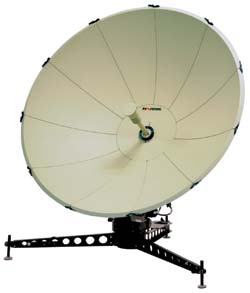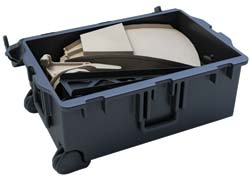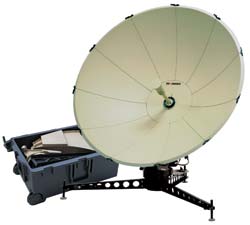
MIlitary missions and natural disaster response share the need for rapid deployment of SATCOM infrastructure under very challenging conditions. Speed, performance and agility are critical, and until now, those capabilities largely have been viewed as incompatible. Greater bandwidth was available, but not in a form factor that could be fielded quickly or easily. Newer VSAT terminals offered more complex capabilities, but required lengthy set-up and adjustments.
Harris Corp.’s 1.3-meter Seeker™ terminal provides support for X-, Ku-, and Ka-Bands in a single transit case that can be checked as airline baggage. Supporting throughput of 8 Mbps, Seeker offers the highest gain possible in a single-case (see Figure 1) antenna that is as small as many 0.9-meter systems.
What makes this possible? Seeker was designed to operate without an antenna controller unit or fans, drastically reducing weight, bulk and noise – as well as cost and power consumption. One battery can provide 80 minutes of airtime in the event of a power interruption.
An integrated RF receiver/transmitter is slice mounted directly to the back of Seeker’s reflector hub, significantly reducing the number of cables required to just five: one input power, one output power, one input GPS, and two transmit/receive cables.
Seeker is self-contained, with a GPS receiver, inclinometer, flux gate compass and simplified keyboard with a built-in display.Its large aperture size reduces the need for ESD spreading, thereby conserving up to 50 percent of satellite transponder bandwidth power compared with 0.6-meter solutions.

Figure 1 Transit case for 1.3-meter Seeker terminal.
Ease of deployment and use are paramount in Seeker’s design. The system can be set up by one person and operating in just 10 minutes. This is due not just to its innovative packaging and agility, but also to its user-friendly Acquisition Wizard. This embedded tool “coaches” the user through three simple steps to signal acquisition using elevation, azimuth and skew angle adjustments.
Even the novice user can acquire and join the satellite network in less than five minutes – something not possible with other VSAT systems, which still require the operator to pre-plan the mission, peak the terminal after acquiring, and fine-adjust the polarization skew angle to align to the target satellite.
Seeker excels in outdoor tactical environments. Its ruggedized electronics can withstand challenging thermal, wind and water conditions with minimal degradation in throughput capability.
Seeker was designed in conjunction with other Harris terminals ranging in size from 0.45 to 3.8 meters. This “family” approach ensures efficient use of common, swappable components such as the modem, power supply, cabling and hardware. Each reflector panel also is interchangeable, simplifying field repairs and lowering sparing costs compared with traditional, matched-set reflector panel configurations. Use of common elements has the added benefit of reduced training time.The product can be bundled with Harris CapRock satellite bandwidth and services to provide a complete end-to-end SATCOM solution anywhere in the world.

Figure 2 Seeker 1.3-meter terminal with transit case.
Seeker has been demonstrated to several government organizations and companies that have recognized itsunique benefits. During a recent demonstration, military attendees commented, “a 1.3-meter terminal in one case (see Figure 2). Seeker’s terminal throughput is impressive for its class. It is so easy to use and the common receive/transmit unit across apertures ranging from 0.45 meters to 1.3 meters allows me to tailor my equipment for my specific mission needs.”
Onsite demos are available.
Harris Corp.,
Melbourne, FL
(321) 729-7863,
www.govcomm.harris.com
